If the newly pedestrianised George Street is the Paris end of Sydney’s CBD, then the middle part of Sussex Street might be the derrière.
Marked by older office blocks, carparks and a Meriton Suites, it’s a far cry from the buzz and style of downtown Tokyo. But that’s what has been created at Prefecture 48, a heritage restoration of an old warehouse building that now boasts four restaurants, a whisky bar and Japanese pâtisserie.
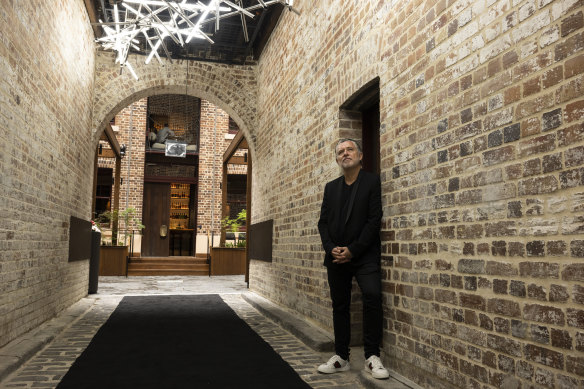
Brenton Smith of Bates Smart hopes he has created a space that will pull Sydneysiders out of their villages and into the city.Credit: Louise Kennerley
The owners, Azabu Group, refused to disclose the cost of the renovation. But in 2021, a heritage restoration of the multi-level Shell House near Wynyard cost a reported $14 million. Those behind the project hope the space itself will engage Sydneysiders with this unloved part of the CBD, and change our relationship with the city itself.
“Sydney is principally a city that was built around one of the most beautiful harbours in the world. We exist around this harbour. It’s our success and our failure,” says Brenton Smith, the director of Bates Smart’s interior design studio.
“What that’s meant is that people often don’t want to come into the city ... everyone stays in their little village. No one wants to go to Coogee, no one wants to go down to Paddington, no one wants to go to the north side.”
Smith should know: he lives in Paddington, but rarely goes into the CBD. “If you compare that to Melbourne, Melbourne is all about the city. Melbourne is absolutely about activation, it’s about getting around, it’s about interfacing with people.
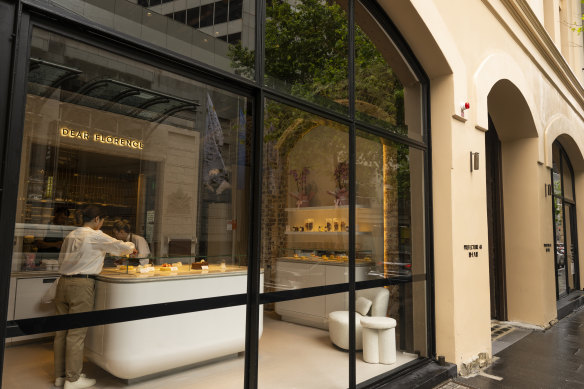
The frontage of the Sussex Street building, which is a heritage-listed former warehouse.Credit: Louise Kennerley
“The more that we can create spaces and buildings that interface with the public, and that people want to go and spend time at, create memories, create stories with their families, that’ll pull them out of their villages.”
It’s a big ask. But Prefecture 48 is designed to intrigue, and to be talked about. From Sussex Street passersby can peer in at the Robata grill or the intricate pâtisserie, but to access them, they need to walk through the giant archway and into the exposed brick corridor. “Once they’re in, they have to kind of meander, and they have to discover the space,” Smith says.
That space is the old Foley Brothers building, circa 1886, once part of a bustling merchant precinct metres from Darling Harbour’s wharves and railways. The state heritage inventory describes it as “a remarkable and largely intact survival of a modest warehouse, cartway and courtyard complex, now extremely rare”.
Inside, visitors might gravitate toward the smoke of the downstairs grill, Ibushi, symbolised with a wispy ceiling installation by Filipino-Belgian wire artist Racso Jugarap, or toward the whisky bar at the rear, with its specially commissioned wallpaper by local tattoo artist Chris Horigo.
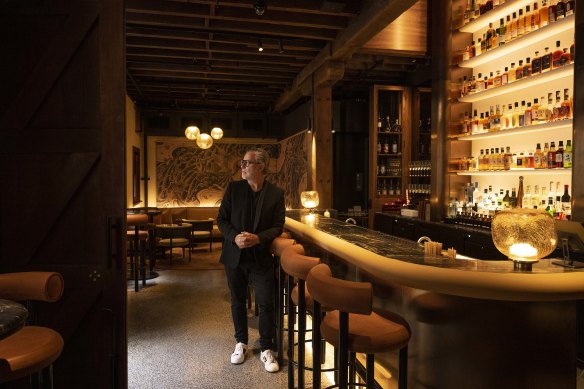
The whisky bar, Whisky Thief.Credit: Louise Kennerley
To get there, they might pull on the huge, cast bronze door handles by Melbourne’s Daniel Barbera, each about 30 centimetres high and 20 centimetres wide, and sit on one of six bar stools by British designer Tom Dixon.
The Herald’s photographer gasps as she enters the upstairs kaiseki restaurant, Garaku, with its dark leathered stone dining bar, tall glass-shielded candles and a large-scale pixel wall by Tokyo spatial director Hiroto Yoshizoe. “It will change with the seasons,” Smith says. “It’s all about the theatre.”
Up one more level is seasonal diner Five, where a work by Japanese ikebana (flower arrangement) artist Yuki Tsuji, made from found timber, hangs from the ceiling. His sculptures also adorn the eight-seat omakase restaurant, a chef-centred Japanese dining tradition that has taken Sydney by storm in recent years.
It’s the kind of place that seems perfect for Instagram, though Smith dismisses that as a dangerous way to design. “If you set out with Instagram in mind, I think you’ve failed already,” he says. “What we set out to do was to curate a lot of very curated perspectives that were really punchy and had a narrative and a story about them. If that’s Instagrammable, that’s great.”
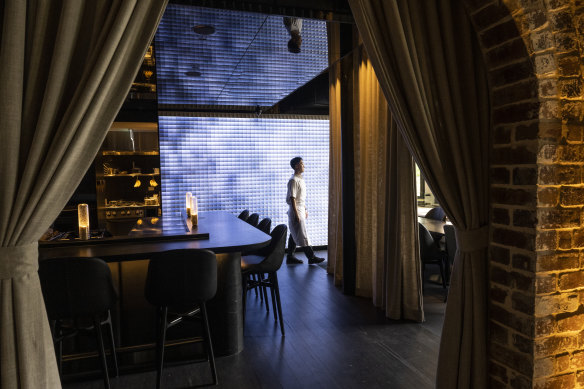
A large-scale pixel wall that changes with the seasons (or through the evening).Credit: Louise Kennerley
But can these lofty ambitions succeed? The precinct around Prefecture 48 is showing early signs of change, with the W Sydney hotel opening at Darling Harbour and some more boutique hotels in the works further down Sussex Street.
The real transformation will come if and when a long-planned redevelopment of Cockle Bay Wharf comes to fruition, including a 43-level office tower and a land bridge over the Western Distributor, featuring a public park. The plan is under departmental assessment.
For now, the area is not blessed with foot traffic, although Smith points out the Sydney CBD is not prohibitively large. “We’re not talking about New York. Sydney’s small. It’s like a 10-minute walk.”
Place and property consultant Andrew Hoyne, whose office is nearby, says he has a newfound love for the area that he didn’t have six months ago. He believes the P48 project will be a magnet for other businesses and drive investment in the precinct.
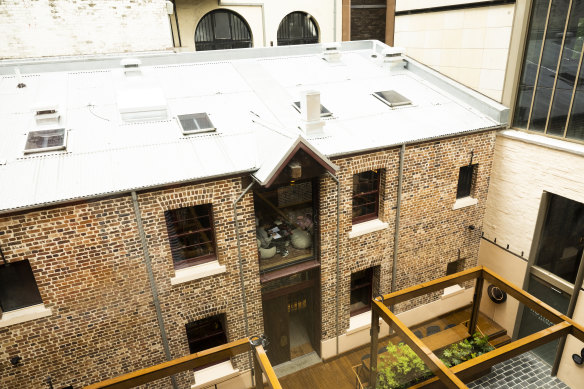
The rear of the block - formerly a warehouse and commercial office - has been turned into a whisky bar.Credit: Louise Kennerley
“What’s really cool about Sussex Street and that area is when you put a different lens on it and take a step back, you go, ‘wow, there’s a whole lot of really beautiful heritage buildings’,” Hoyne says.
“I think they’ve had some bad tenants and lacked a bit of love. I’ve always thought of Sussex Street as being a bit gritty [and] that whole part of town is just coming alive. All the most interesting bars are sort of in that neck of the woods and also driving themselves towards Chinatown.”
Smith hopes P48 will become a destination that draws people out of their bubbles – and yes, their villages. “If you build somewhere that has enough gravitas and enough pull, people will come. It’s not just another restaurant, it’s a venue that will be a global conversation, rather than just a local conversation. That’s the other thing that Sydney needs more of. We often get forgotten.”
Get the day’s breaking news, entertainment ideas and a long read to enjoy. Sign up to receive our Evening Edition newsletter here.